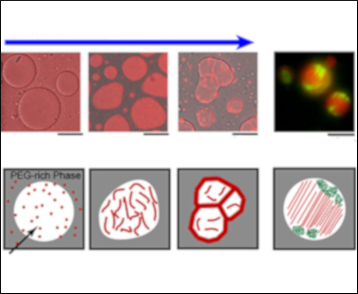The spatial organization of the different compartments in cells is important for the proper function of vital processes. Phase separation could play an important role in this organization of the various structures and organelles inside living cells.
Kingo Takiguchi, Nagoya University, Japan, Kanta Tsumoto, Mie University, Japan, and colleagues used cell-sized aqueous/aqueous microdroplets (CAMDs) to study such processes. The team prepared a simple binary polymer system from poly(ethylene glycol) (PEG) and dextran, which causes the formation of the desired droplets through water/water microphase segregation. Then they studied the localization of DNA and different actins (a type of protein) in the system.
The researchers found that DNA was entrapped within the cell‐sized droplets. Similarly, F‐actin, a linearly polymerized actin, was entrapped in the droplets, while G‐actin, a monomeric actin, was distributed evenly inside and outside these droplets. When both DNA and F‐actin were used, DNA molecules were localized separately from the F‐actin proteins and “subcellular” microdomains were created inside the droplets.
The results could help to shed further light on the significant role of phase separation in the formation of cell organelles.
- Specific Spatial Localization of Actin and DNA in a Water/Water Microdroplet: Self-Emergence of a Cell-Like Structure,
Naoki Nakatani, Hiroki Sakuta, Masahito Hayashi, Shunsuke Tanaka, Kingo Takiguchi, Kanta Tsumoto, Kenichi Yoshikawa,
ChemBioChem 2018.
https://doi.org/10.1002/cbic.201800066




